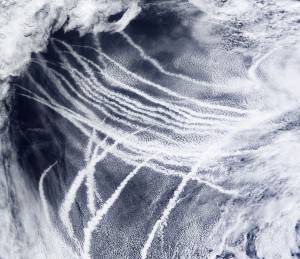This article is more than 1 year old
Cloud engineering could save humantiy, suggests boffin
Actual clouds in the sky, not IT ones, sorry
Opinion Experiments should be carried out into creating artificial clouds to fight global warming, scientists have argued. Clouds generated by special ships at sea would reflect solar heat back into space, so serving to cool the planet.
Atmospheric physicist Rob Wood and his colleagues think that the idea of artificial cumulo-mirrors is well worth checking out, just in case China and India and the rest of the developing world should decide for some reason to industrialise their economies and consume huge amounts more energy. There is also the possibility that the existing developed world will decline to massively slash its energy consumption and switch to cripplingly expensive renewable power for its remaining requirements.
In fact that's exactly what is happening, so - assuming for the moment that global warming is a real and terrible menace - perhaps Wood has a point.
"It's a quick-fix idea when really what we need to do is move toward a low-carbon emission economy, [but that's] turning out to be a long process," argues the prof. "I think we ought to know about the possibilities, just in case."
In essence the idea would be to exploit the already-known phenomenon of "ship clouds", where vessels underway at sea find a long trail of cloud forming behind them. At the moment this is generally a case of water droplets coalescing around particulates emitted from the ship's exhaust funnel, but this would be impractical and polluting on a scale that could affect the global climate.
Rather, the idea being touted here is to use special vessels which would spout huge amounts of sea salt particles - generated from the ocean - into the air as they went along. Water droplets should then form around the particles, creating long-lived clouds that wouldn't have any polluting qualities. The clouds would hopefully be bright, white and large enough to felect useful amounts of solar heat back into space and so to combat global warming.

See? It does work
According to a statement issued by Wood's university:
Wood and his colleagues propose trying a small-scale experiment to test feasibility and begin to study effects. The test should start by deploying sprayers on a ship or barge to ensure that they can inject enough particles of the targeted size to the appropriate elevation. An airplane equipped with sensors would study the physical and chemical characteristics of the particles and how they disperse.
The next step would be to use additional airplanes to study how the cloud develops and how long it remains. The final phase of the experiment would send out five to 10 ships spread out across a 100 kilometer, or 62 mile, stretch. The resulting clouds would be large enough so that scientists could use satellites to examine them and their ability to reflect light.
"What we're trying to do is make the case that this is a beneficial experiment to do," argues the atmo-boffin. "I would rather that responsible scientists test the idea than groups that might have a vested interest in proving its success."
Such "geo-engineering" plans are always controversial, with objections generally advanced to the effect that they may have unforeseen consequences and that they would permit a lazy humanity to shirk its perceived duty to cease burning carbon. Nonetheless many scientists have assessed that geo-engineering schemes could be hugely less costly and traumatic for humanity than the efforts required to seriously cut carbon emissions - and thus, that geo-engineering might be politically feasible, which so far doesn't seem to be the case for global carbon cuts.
Woods and his colleagues' new paper is published here in the Philosophical Transactions of the Royal Society. ®
